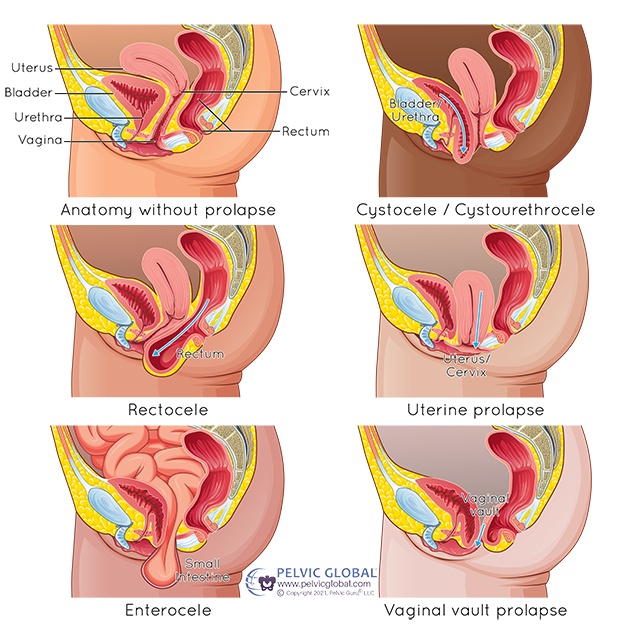
🌼 June is Prolapse Awareness Month! 🌼
Understanding Pelvic Organ Prolapse:
Pelvic organ prolapse (POP) occurs when one or more organs in the pelvic region, such as the uterus, bladder, or rectum, descend from their normal positions and protrude into or outside the vaginal canal. It can be caused by various factors, including pregnancy and childbirth, menopause, chronic constipation, obesity, and repetitive heavy lifting.
Prolapse can lead to discomfort, pain, urinary or fecal incontinence, and impact one’s quality of life.
As seen on the images above there are different types of prolapses that can occur.
1.Cystocele (Anterior Vaginal Prolapse): refers to the descent of the bladder into the vaginal canal. Weakness or damage to the front vaginal wall and the supporting tissues can contribute to this. Factors such as childbirth, aging, and hormonal changes can weaken the pelvic floor muscles and connective tissues, leading to cystocele. Symptoms may include urinary incontinence, frequent urination, and a bulging sensation in the vaginal area.
2. Rectocele (Posterior Vaginal Prolapse):occurs when the rectum bulges into the back vaginal wall. Similar to cystocele, weakened or damaged pelvic floor muscles and connective tissues play a significant role in this type of prolapse. Chronic constipation, childbirth, and aging are common contributing factors. Symptoms may include difficulty with bowel movements, a feeling of pressure in the rectal area, and a protrusion in the vagina during bowel movements.
3. Uterine Prolapse: involves the descent of the uterus into the vaginal canal. Weakened or damaged pelvic floor muscles and ligaments often contribute to this condition. Factors such as multiple pregnancies, vaginal childbirth, obesity, and hormonal changes can increase the risk of uterine prolapse. Symptoms may include a sensation of pelvic pressure or heaviness, lower back pain, and difficulties with sexual intercourse.
4. Enterocele: is characterized by the herniation of the small intestine into the vaginal canal. Weakness or damage to the pelvic floor muscles and connective tissues can lead to this condition. Enterocele is often associated with previous pelvic surgeries, such as hysterectomy. Symptoms may include lower abdominal or pelvic pain, discomfort during sexual intercourse, and a feeling of fullness or pressure
One of the most effective non-surgical treatments for pelvic organ prolapse is pelvic floor physical therapy. Pelvic floor PT can teach you how to strengthen the muscles around the area including the pelvic floor to provide support to the organs in the pelvis. Pelvic floor physical therapy can also help with other symptoms that can occur with POP like pelvic pain, bowel and bladder function, and constipation. The goal of pelvic floor physical therapy include improving muscle tone, restoring function, and alleviating symptoms associated with prolapse.
Pelvic physical therapists can educate you on proper body mechanics, breathing techniques, safe exercises and some exercise you might want to be avoid.
Pelvic floor physical therapy is not only beneficial for those currently experiencing prolapse but also serves as an excellent preventive measure. Strengthening the pelvic floor muscles before childbirth, during menopause, or in cases of increased intra-abdominal pressure can reduce the risk of prolapse or mitigate its severity.
💚 Together, let’s promote pelvic floor health and spread awareness about pelvic organ prolapse.
Please reach out if you have any questions.
Image used with permission from Pelvic Guru®, LLC
www.pelvicglobal.com
